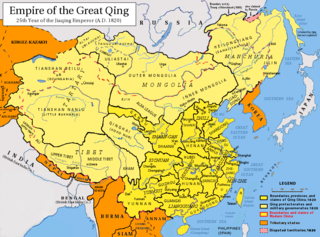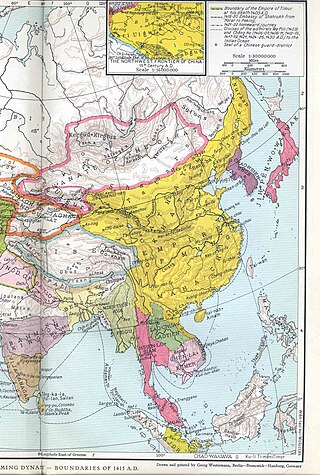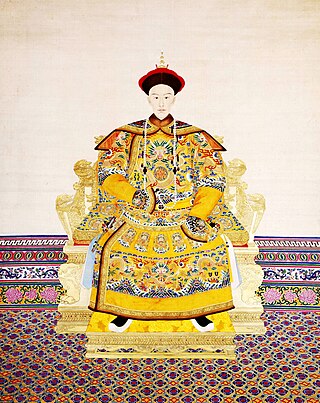
Manchuria refers to a region in Northeast Asia encompassing the entirety of present-day Northeast China or, historically, those areas combined with parts of the Russian Far East which are often referred to as Outer Manchuria. Its definition may refer to varying geographical extents as following: the Chinese provinces of Heilongjiang, Jilin, and Liaoning but broadly also including the eastern Inner Mongolian prefectures of Hulunbuir, Hinggan, Tongliao, and Chifeng, collectively known as Northeast China. Historically included homeland of the Jurchens and later their descendants Manchus, which was controlled in whole by Qing China prior to the Amur Annexation in 1858–1860, when parts of the historical region were ceded to the Russian Empire. The two areas involved are Priamurye between the left bank of Amur River and the Stanovoy Range to the north; and Primorskaya which runs down the Pacific coast from the Amur Estuary to the Russo-Korean border, sometimes including the island of Sakhalin, collectively known as Outer Manchuria or Russian Manchuria.
The Manchus are a Tungusic East Asian ethnic group native to Manchuria in Northeast Asia. They are an officially recognized ethnic minority in China and the people from whom Manchuria derives its name. The Later Jin (1616–1636) and Qing (1636–1912) dynasties of China were established and ruled by the Manchus, who are descended from the Jurchen people who earlier established the Jin dynasty (1115–1234) in northern China. Manchus form the largest branch of the Tungusic peoples and are distributed throughout China, forming the fourth largest ethnic group in the country. They can be found in 31 Chinese provincial regions. Among them, Liaoning has the largest population and Hebei, Heilongjiang, Jilin, Inner Mongolia and Beijing have over 100,000 Manchu residents. About half of the population live in Liaoning and one-fifth in Hebei. There are a number of Manchu autonomous counties in China, such as Xinbin, Xiuyan, Qinglong, Fengning, Yitong, Qingyuan, Weichang, Kuancheng, Benxi, Kuandian, Huanren, Fengcheng, Beizhen and over 300 Manchu towns and townships. Manchus are the largest minority group in China without an autonomous region.
Jurchen is a term used to collectively describe a number of East Asian Tungusic-speaking people. They lived in northeastern China, also known as Manchuria, before the 18th century. The Jurchens were renamed Manchus in 1635 by Hong Taiji. Different Jurchen groups lived as hunter-gatherers, pastoralist semi-nomads, or sedentary agriculturists. Generally lacking a central authority, and having little communication with each other, many Jurchen groups fell under the influence of neighbouring dynasties, their chiefs paying tribute and holding nominal posts as effectively hereditary commanders of border guards.

Manchuria is a region in East Asia. Depending on the definition of its extent, Manchuria can refer either to a region falling entirely within present-day China, or to a larger region today divided between Northeast China and the Russian Far East. To differentiate between the two parts following the latter definition, the Russian part is also known as Outer Manchuria, while the Chinese part is known as Northeast China.

Northeast China is a geographical region of China. It usually corresponds specifically to the three provinces east of the Greater Khingan Range, namely Liaoning, Jilin, and Heilongjiang, but historically is meant to also encompass the four easternmost prefectures of Inner Mongolia west of the Greater Khingan. The heartland of the region is the Northeast China Plain, the largest plain in China, with an area of over 350,000 km2 (140,000 sq mi). It is separated from Russian Far East to the north by the Amur, Argun, and Ussuri Rivers; from Korea to the south by the Yalu and Tumen Rivers; and from Inner Mongolia to the west by the Greater Khingan and parts of the Xiliao River.
Manchurians may refer to people inhabiting:
The Jianzhou Jurchens were one of the three major groups of Jurchens as identified by the Ming dynasty. Although the geographic location of the Jianzhou Jurchens changed throughout history, during the 14th century they were located south of the Wild Jurchens and the Haixi Jurchens, and inhabited modern-day Liaoning and Jilin provinces in China. The Jianzhou Jurchens were known to possess an abundant supply of natural resources. They also possessed industrial secrets, particularly in processing ginseng and the dyeing of cloth. They were powerful due to their proximity to Ming trading towns such as Fushun, Kaiyuan, and Tieling in Liaodong, and to Manpojin camp near Korea.
The Mohe, Malgal, or Mogher, or Mojie, were historical groups of people that once occupied parts of Southeastern Siberia in what's now Northeast Asia during late antiquity. The two most well known Mohe groups were known as the Heishui Mohe, located along the Amur River, and the Sumo Mohe, named after the Songhua River. They have been traditionally defined by their eastwards proximity to Goguryeo as well as the approximate use of what would have been Proto-Tungusic languages. The Heishui Mohe are commonly thought as being direct ancestors to the 12th century Jurchens.

Tungusic peoples are an ethnolinguistic group formed by the speakers of Tungusic languages. They are native to Siberia, China, and Mongolia.

Yilou is the modern Chinese name of a people in 3rd- to 6th-century Manchuria.
Chuang Guandong is descriptive of the rush of Han people into Manchuria, mainly from the Shandong Peninsula and Zhili, during the hundred-year period beginning in the last half of the 19th century. During the first two centuries of the Manchu-led Qing dynasty, this part of China, the traditional homeland of the ruling Manchus, was, with few exceptions, closed to settlement by Han civilians, with only certain Manchu bannermen, Mongol bannermen, and Han bannermen allowed in. The Manchuria/Northeast China area now has an overwhelmingly Han population.
The Manchu people are a Tungusic people who originated in Manchuria.

Manchu cuisine or Manchurian cuisine is the cuisine of Manchuria and Russian Manchuria. It uses the traditional Manchu staple foods of millet, soybean, peas, corn and broomcorn. It relies heavily on preserved foods due to the harsh winters and scorching summers in Northeast China. Manchu cuisine is also known for grilling, wild meat, strong flavours and the wide use of soy sauce. Manchu cuisine is more wheat based than Han Chinese cuisines.

Manchurian nationalism or Manchu nationalism refers to the ethnic nationalism of the Manchu people or the territorial nationalism of the inhabitants of Manchuria, regardless of ethnic origin.

The Qing dynasty in Inner Asia was the expansion of the Qing dynasty's realm in Inner Asia in the 17th and the 18th century AD, including both Inner Mongolia and Outer Mongolia, both Manchuria and Outer Manchuria, Tibet, Qinghai and Xinjiang.

Manchuria under Ming rule refers to the domination of the Ming dynasty of China over the greater region of Manchuria, including today's Northeast China and Outer Manchuria. The Ming rule of Manchuria began with its conquest of Manchuria in the late 1380s after the fall of the Mongol-led Yuan dynasty, and reached its peak in the early 15th century with the establishment of the Nurgan Regional Military Commission. With the dissolution of the Nurgan Regional Military Commission the Ming power waned considerably in Manchuria. Starting in the 1580s, Nurhaci, the Jianzhou Jurchen chieftain who had been a Ming vassal, began to take control of most of Manchuria over the next several decades, and in 1616 he established the Later Jin and openly renounced Ming overlordship with the Seven Grievances. The Qing dynasty established by his son Hong Taiji would eventually conquer the Ming and take control of China proper.

Manchuria under Qing rule was the rule of the Qing dynasty of China over the greater region of Manchuria, including today's Northeast China and Outer Manchuria, although Outer Manchuria was lost to the Russian Empire after the Amur Annexation. The Qing dynasty itself was established by the Manchus, a Tungusic people from Manchuria, who later replaced the Ming dynasty as the ruling dynasty of China. Thus, the region is often seen to have had a special status during the Qing and was not governed as regular provinces until the late Qing dynasty, although the name "Manchuria" itself is an exonym of Japanese origin and was not used by the Qing dynasty in Chinese or Manchu.

The Later Jin, officially known as Jin or the Great Jin, was a Jurchen-led royal dynasty of China in Manchuria and the precursor to the Qing dynasty. Established in 1616 by the Jianzhou Jurchen chieftain Nurhaci upon his reunification of the Jurchen tribes, its name was derived from the earlier Jin dynasty founded by the Wanyan clan which had ruled northern China in the 12th and 13th centuries.

The Sinicization of the Manchus is the process in which the Manchu people became assimilated into the Han-dominated Chinese society. It had occurred most prominently during the Qing dynasty when attempts were made by the new Manchu rulers of China to assimilate themselves and their people with the Han under the new dynasty to increase its legitimacy.










